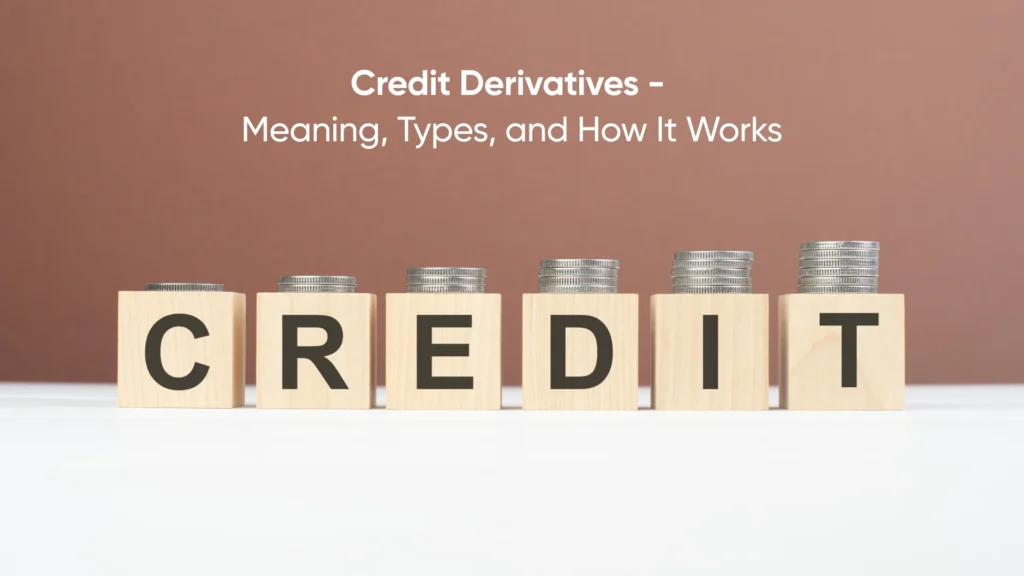Credit Derivatives - Meaning, Types, and How It Works

Credit derivatives are financial instruments that allow the investor to mitigate credit risk. They enable the transfer of credit risk from one party to another, without owning any underlying asset. The creditor can transfer the risk of the debtor to another third party.
For instance, Bank A lends ₹1 Crore to Company X but is concerned about default risk. To hedge, Bank A enters into a Credit Derivative agreement with Investor B (a hedge fund). Bank pays Investor B a 2% annual premium in exchange for protection. If Company X defaults, Investor B compensates Bank A for the loss else Investor B keeps the premium. This allows Bank A to manage risk while Investor B earns returns for taking on credit exposure.
Table of Contents
ToggleKey Features of Credit Derivatives
Risk Transfer: The main purpose of credit derivatives is to transfer the credit risk from one party to another. They are privately held negotiable contracts between two parties.
Credit Exposure: This means that the credit derivative is based on the financial condition of a particular borrower, and if certain trigger events happen, the contract will be paid out to help cover losses.
Standardization: Credit derivatives like standardized CDS contracts, are traded on established platforms with common terms and conditions.
Customization: Depending on the needs of the parties involved, certain aspects of the contract (like the definition of credit events or the notional amount) can be customized.
Notional Amount: This is the total value of the assets that are being leveraged as per the contract.
Premium and Payout Structure: The protection buyer pays periodic premiums, and the seller compensates the buyer if a predefined credit event occurs.
Maturity: Credit derivatives typically have a defined maturity date, after which the contract expires.
These features make credit derivatives a powerful tool for managing credit risk but also a complex financial instrument requiring careful risk assessment.
How Do Credit Derivatives Work?
Credit derivatives function by providing protection or exposure to the credit risk associated with a specific credit event.
There are two main parties involved. The protection buyer and protection seller. The protection buyer wants insurance against the credit risk when a specific credit event occurs. The protection seller agrees to cover the risk in exchange for premium payments. The specific credit event includes default or bankruptcy, trigger the contract’s payout or other specified obligations.
Credit derivatives are mostly used by banks and experienced investors to hedge against defaults and fluctuation in credit risks.
Major Types of Credit Derivatives
The major types of credit derivatives include:
Credit Default Swaps (CDS): CDS involves an investor to swap their credit risk to another investor. The buyer pays a premium and the seller agrees to pay the securities value in case of defaults.
Total Return Swaps (TRS): A Total Return Swap (TRS) is a financial contract where one party agrees to pay the total return (capital gains + interest/dividends) of an asset, like a stock or bond, to another party in exchange for a fixed or floating interest payment.
Collateralized Debt Obligations (CDOs): Collateralized Debt Obligations pool various financial products like bonds. These instruments are then divided into tranches as per their risk and return.
Credit Linked Notes (CLNs): Credit Linked Notes is a financial instrument that is just like a bond but with a credit insurance feature. For instance, a bank issues a Credit-Linked Note (CLN) tied to Company X. If Company X defaults, investors lose money. If not, they earn regular interest.
Benefits & Risks of Credit Derivatives
Benefits of Credit Derivatives
Risk Management: Credit derivatives enable financial institutions to mitigate credit risk to another party, reducing their risk with defaults and thereby reducing potential losses.
Increased Liquidity: Banks have more liquidity as they pass the risk to others. This allows them to offer more loans without needing to keep large cash reserves.
Portfolio Diversification: Credit derivatives allow investors to diversify their investment portfolio as they can mitigate the risk.
More Returns: Market participants can invest in high risk, high returns investments as the risk gets mitigated.
Better Pricing: Pricing becomes more effective because credit derivatives allow banks and investors to trade and transfer credit risk in the open market. When many buyers and sellers participate, market forces determine fair prices based on actual risk rather than estimates.
Risks with Credit Derivatives
Credit derivatives may pose the following risk:
Concentration Risk: This implies that the market participant has a large exposure to a single sector, industry, or region. This increases the concentration risk for the participant.
Counterparty risk: Credit derivatives is an agreement between two parties. There is a risk that one party may default, leading to counterparty risk.
Market risk: Credit derivatives are subject to market risk. The value of the derivative may fluctuate due to market conditions, like changes in interest rates.
Liquidity risk: Liquidity risk refers to the difficulty of buying or selling an asset quickly without affecting its price. In the case of credit derivatives, these financial products are not as widely traded as stocks or bonds. If you want to sell or exit your position in a credit derivative, it may not be easy to find a buyer.
Complexity: Credit derivatives can be complex financial instruments that can make it difficult for market participants to understand. This may lead to mispricing and increased risk.
Real-World Examples of Credit Derivatives
The real-world examples of credit derivatives:
1. Credit Default Swaps (CDS) – 2008 Financial Crisis
During the 2008 financial crisis, banks and investors used credit default swaps (CDS) to hedge against the risk of mortgage-backed securities defaulting. However, when the housing market collapsed, institutions like AIG had sold too many CDS contracts without enough reserves to cover losses. This led to massive bailouts and financial instability.
2. CDS on Greek Government Bonds – European Debt Crisis
In the early 2010s, investors used credit default swaps on Greek government bonds to hedge against Greece defaulting on its debt. When Greece faced a financial crisis and needed bailouts, those holding CDS contracts received payouts, while those who sold CDS contracts suffered heavy losses.
3. JP Morgan’s “London Whale” Trading Loss (2012)
JP Morgan’s trading desk used credit derivatives to hedge risks, but excessive and complex trading in CDS markets led to a $6 billion loss due to market mispricing and lack of liquidity. This incident highlighted the risks of speculative trading with credit derivatives.
Differences Between Credit Derivatives & Other Derivatives
While all derivatives serve as tools for managing risk, credit derivatives and other derivatives (like interest rate, currency, and commodity derivatives) differ in their underlying assets and the risks they aim to manage. Let us understand the difference between them:
Feature | Credit Derivatives | Other Derivatives (Interest Rate, Currency, Commodity, Equity) |
Underlying Asset | Based on credit risk of loans, bonds, or companies | Based on interest rates, currencies, commodities, or stocks |
Purpose | Protects against default risk if the borrower fails to repay | Protects against price fluctuations (e.g., stock prices, interest rates, commodity prices) |
Example | Credit Default Swap (CDS) – Insurance against a company defaulting on its debt | Interest Rate Swap – Interest rate Swap lock in a fixed interest rate to avoid rising rates |
Who Utilizes It? | Banks, investors, lenders managing default risk | Traders, companies, banks managing price risks |
Risk Type | Credit Risk – To cover the risk that a borrower or company won’t pay debt | Market Risk – To cover the risk of price fluctuation of assets |
Market Liquidity | Less liquid. Credit derivatives can be difficult to sell in a crisis | More liquid. They are widely traded in financial markets |
Conclusion:
Credit derivatives may be a good tool to manage and mitigate credit risk. However, this option may not be for everyone. They have their own set of complexities and risks. It is important to gauge your understanding of credit derivatives, risk tolerance and your financial goals to determine if they are the right choice for you. Seek expert advice if you are unsure.
Frequently Asked Questions
What Do You Mean By Credit Derivatives?
Credit derivatives are a financial instrument that allows creditors to mitigate risk on the debtor to a third party.
Is A Bond A Credit Derivative?
No, a bond is not a credit derivative. It is a debt instrument where you lend money to an issuer, in exchange for interest payments and principal amount upon maturity.
What Are The Different Types Of Credit Derivatives?
The different types of credit derivatives include Credit default swaps (CDS), Credit-linked notes (CLN), Total Return Swaps (TRS) and Collateralized Debt Obligations (CDOs)
How Do Credit Default Swaps (Cds) Work?
Credit default swap is a contract in which a buyer pays a premium to the seller to protect against borrower defaulting. If an investor is holding bonds, a Credit Default Swap is like insurance: you pay a premium, and if the bond issuer defaults, the CDS pays out to help cover your losses.
Are Credit Derivatives Safe For Investors?
Credit derivatives can be risky because they involve complexities. They might suit experienced investors with high-risk tolerance, but they may not be suitable for beginners.
How Are Credit Derivatives Regulated In India?
The Reserve Bank of India regulates credit derivatives in India by issuing regulations, circulars, and directions to regulate the derivatives market and contracts.
What Are The Key Risks Associated With Credit Derivatives?
The key risks associated with credit derivatives include counterparty risk, leverage risk, market risk, and liquidity risks.
What Is The Difference Between Interest Rate Derivatives And Credit Derivatives?
Interest rate derivatives lock in a certain interest rate on a loan or bond, while credit derivatives reduce the risk of default on a loan or bond.
Who Invented Credit Derivatives?
Credit derivatives were pioneered by J.P. Morgan in the early 1990s. Peter Hancock laid the foundation for credit derivatives, while Blythe Masters helped bring them into mainstream finance.
YOU MAY ALSO LIKE

Search by posts
Recent post
-
 समान मासिक किस्त: आपकी वित्तीय खर्चों को आसान बनाने वाला तरीका
समान मासिक किस्त: आपकी वित्तीय खर्चों को आसान बनाने वाला तरीका
-
 Apply for 50000 Rupees Loan Urgently: Get Disbursed in Few Minutes
Apply for 50000 Rupees Loan Urgently: Get Disbursed in Few Minutes
-
 How to get Instant Loan on Aadhaar Card without Salary Slip
How to get Instant Loan on Aadhaar Card without Salary Slip
-
 How to Apply for a Rs. 25,000 Loan on an Aadhaar Card?
How to Apply for a Rs. 25,000 Loan on an Aadhaar Card?
-
 How to Get ₹30,000 loan without income proof: Quick Ways
How to Get ₹30,000 loan without income proof: Quick Ways
Categories
- Blog (6)
- Credit History (36)
- Credit Line (7)
- Festive (4)
- Finance (15)
- Mutual Fund (19)
- Personal Loan (275)
- Tax (8)
- Zype (4)













